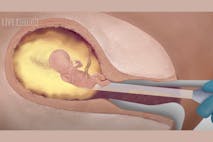
Former police officer faces charges in death of preborn baby
Bridget Sielicki
·
FACT CHECK: NYT claims pro-life laws are to blame for increased infant mortality
On Thursday, the New York Times (NYT), alongside several other mainstream media outlets, published a biased analysis of new studies indicating infant mortality increased by six percent in states that enacted pro-life laws.
The implication of these analyses is that, as CNN puts it, “abortion bans” are actually “exacerbating existing health disparities” and leading to more infant deaths than before abortion was restricted. This perspective, however, fails to take into account that, prior to the enactment of the pro-life laws in question, thousands of infants each year were killed in the womb before their deaths could be counted toward an “infant mortality” rate.
Furthermore, the NYT and other outlets have characterized the increased occurrences of infant death as unfortunate consequences of mothers being unable to choose to kill their children in advance. Dr. Alyssa Bilinski, one researcher cited by the NYT, writes that, “The groups that are most likely to have children as a result of abortion bans are also individuals who are most likely, for a number of different reasons, to have higher rates of infant mortality.”
The two groups that the NYT singles out as suffering most from greater incidence of infant mortality are mothers of infants who are either Black or have a disability – children who, prior to the enactment of pro-life laws, would also have been most at risk to be aborted based on historical data.
“All of these ‘excess’ children who were born would have been killed in induced abortions,” Dr. Donna Harrison, director of research for the American Association of Pro-Life Obstetrician and Gynecologists (AAPLOG), told the NYT. “This means that anyone lamenting the results of this study isn’t really concerned that these babies died; rather, they wish they would have been killed earlier: in the womb.”
Claim #1: “Infant mortality increased along with births in most states with abortion bans in the first 18 months after the Supreme Court overturned Roe v. Wade […]”
The majority of mainstream media outlets reporting on the newly-released data have emphasized the claim that infant mortality increased in states after the enactment of pro-life laws prohibiting abortions. What the NYT and other pro-abortion commentators fail to mention, however, is that the only state where a statistically significant change in infant mortality was observed was Texas; all other states considered in the study displayed no difference from zero.
While the NYT acknowledges the outsized impact of Texas data on the study as a whole, the outlet fails to note that, without the inclusion of Texas, the study could not have identified a change in infant mortality.
Claim #2: “[…] in the states that implemented near-total abortion bans or bans after six weeks’ gestation during that period, there were 478 more deaths of babies […] than would have been expected based on previous years’ data.”
The NYT implies that the enactment of pro-life laws led to the deaths of more infants than would have been expected based on historical data. Considering the thousands of infants that pro-life laws save from being killed in the womb each year, however, infant mortality has decreased in every state with a pro-life protection in place.
While the increased rate of infant mortality is based on an additional 478 infants who died in their first year of life than would have been expected, estimates show over 22,000 children were born because of safeguards for children in the womb. Though the death of any infant, preborn or born, is undoubtedly a tragedy, the actual survival outcome for infants is far improved in states that have enacted laws protecting human life in the womb.
Claim #3: “When women are not allowed to end pregnancies of fetuses with congenital anomalies, the babies often die within days or weeks after birth.”
Pro-abortion commentators often claim that exceptions to pro-life laws in cases of a prenatal diagnosis of a disability, especially those considered life-limiting or “lethal,” are necessary to prevent suffering and trauma for the mother and infant. In this article, the NYT makes the bizarre claim that, when mothers cannot kill a child with a life-limiting disability in the womb, the child will likely go on to die soon after birth, thus contributing to infant mortality numbers.
According to those with experience handling the death of an infant from a life-limiting disability, such as parents and perinatal hospice staff, choosing life for a child likely to die soon after birth prevents a greater tragedy. In either event, the infant may die – the difference is only whether he or she is intentionally killed in the womb or dies naturally after birth while receiving comfort and love from his or her family.
Furthermore, physicians note that prenatal testing is often inaccurate in diagnosing the presence of disabilities, including life-limiting ones; inaccurate prenatal testing has led to many children being aborted who may have gone on to be born without any challenges at all. In a video for Live Action, neonatologist Dr. Kendra Kolb explains that, “If allowed to be born, some of these babies may in fact turn out to be perfectly healthy if they were misdiagnosed, and others may indeed have some special needs, but ultimately live a long and happy life.”
There is more to be done – but pro-life laws are preventing infant deaths in the meantime
One central conclusion of both the NYT article and the research studies themselves is that increases in infant mortality are indicative of gaps in health care and other areas of need for vulnerable parents. As the NYT put it, “nobody is in favor of infants dying.”
In that case, however, the outlet should be happy to know that pro-life laws are not causing infant deaths, but rather saving thousands of infants’ lives each year.
Live Action News is pro-life news and commentary from a pro-life perspective.
Contact editor@liveaction.org for questions, corrections, or if you are seeking permission to reprint any Live Action News content.
Guest Articles: To submit a guest article to Live Action News, email editor@liveaction.org with an attached Word document of 800-1000 words. Please also attach any photos relevant to your submission if applicable. If your submission is accepted for publication, you will be notified within three weeks. Guest articles are not compensated (see our Open License Agreement). Thank you for your interest in Live Action News!

Bridget Sielicki
·
Fact Checks
Nancy Flanders
·
Fact Checks
Madison Evans
·
Fact Checks
Nancy Flanders
·
Fact Checks
Nancy Flanders
·
Fact Checks
Nancy Flanders
·
Issues
Joy Stockbauer
·
Analysis
Joy Stockbauer
·
Human Interest
Joy Stockbauer
·
Human Interest
Joy Stockbauer
·
International
Joy Stockbauer
·